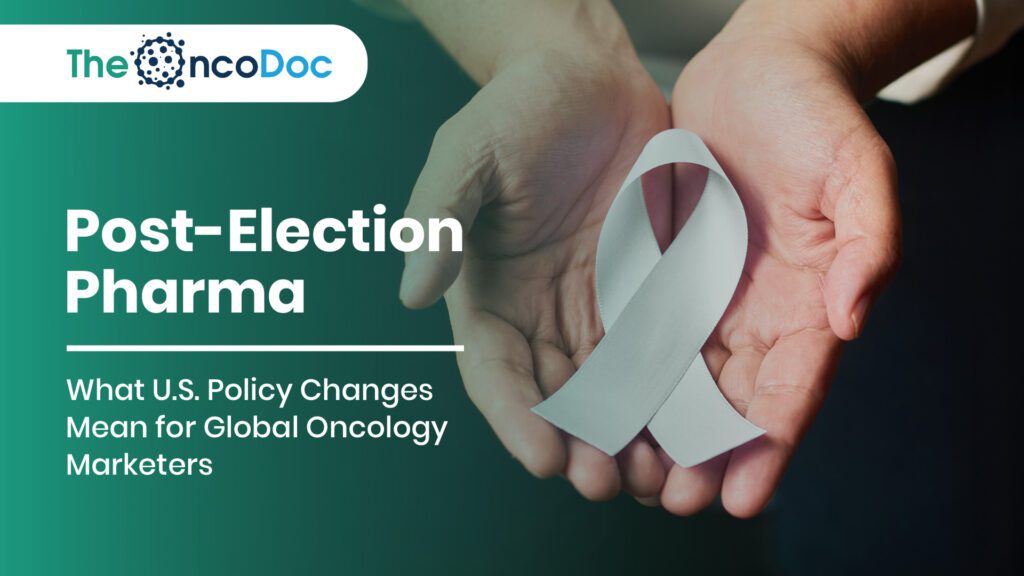Abstract
The outcome of U.S. elections often ushers in significant policy changes with far-reaching consequences that extend well beyond national borders. For global oncology marketers, these shifts—particularly in areas of drug pricing, regulatory approval, and trade- are not just domestic concerns; they are critical determinants of global strategy. This article offers a comprehensive and educational analysis of how potential U.S. policy changes, driven by a new political administration, can create a ripple effect across the global oncology market. We explore how marketers must proactively adapt their digital strategies to navigate new compliance requirements, manage evolving value propositions, and maintain brand trust with both healthcare professionals (HCPs) and patients worldwide. By focusing on key digital marketing analytics, we offer a strategic framework for pharma managers to measure, predict, and respond to these post-election dynamics, ensuring that their global campaigns remain effective, compliant, and patient-centric.
Introduction: When the U.S. Ballot Casts a Global Shadow
In the world of medical oncology, the United States is more than just a market; it is a global benchmark. Its policies on drug development, pricing, and regulation often set precedents that influence healthcare systems and pharmaceutical strategies around the world. Consequently, the results of a U.S. election, with the potential for new legislative and regulatory agendas, are a matter of intense interest for global oncology marketers. The period following an election is not a time for passive observation; it is a critical window for strategic foresight and agile adaptation.
The challenge lies in translating the high-level policy rhetoric into tangible marketing strategies. For a global oncology brand, a change in U.S. drug pricing policy can necessitate a total recalibration of its global value proposition. A shift in FDA regulations can impact how a drug is positioned in Europe or Asia. In this dynamic environment, digital marketing and its associated analytics become an indispensable tool. This article will guide pharma managers through this complex landscape, exploring how to anticipate and respond to U.S. policy changes, leveraging digital channels to maintain market position, manage reputation, and ultimately, continue to serve the global oncology community effectively.
Part I: The Policy Levers of Change and Their Global Ripple Effect
U.S. elections can trigger policy shifts in three key areas, each with a distinct global impact on oncology marketing.
1. Drug Pricing and Reimbursement Policies One of the most immediate and contentious areas of post-election policy is drug pricing. Initiatives such as the Inflation Reduction Act’s provisions for Medicare drug price negotiation and other efforts to lower out-of-pocket costs can have profound effects.
- Global Marketing Impact: The U.S. is often used as a reference for drug pricing in many other countries. A significant reduction in a drug’s price in the U.S. can create pressure from foreign governments and healthcare systems to lower prices in their own markets. For global marketers, this necessitates a fundamental reassessment of their value proposition. The focus must shift from justifying a high price to highlighting the broader economic and clinical value of the therapy, including its impact on long-term healthcare costs and quality of life. Campaigns must be carefully localized to address each country’s specific reimbursement and patient access concerns.
- Analytics Focus: Marketers use digital analytics to track the performance of value-based content across different geographies. Metrics include engagement with health economics and outcomes research (HEOR) content, click-through rates on patient access and support program information, and social media sentiment analysis to gauge public perception of brand value in various regions.
2. FDA Regulatory and Approval Pathways The U.S. FDA’s approach to drug approval and post-market surveillance can change with a new administration. While the FDA operates as an independent body, its priorities can align with broader governmental directives, such as a greater emphasis on using Real-World Evidence (RWE) or a shift in the speed of approval pathways.
- Global Marketing Impact: FDA approval is often a gold standard for regulatory bodies worldwide. Changes in the speed or nature of FDA approvals can impact the timelines for submissions to other regulatory agencies like the European Medicines Agency (EMA) or Japan’s Pharmaceuticals and Medical Devices Agency (PMDA). This creates a new marketing challenge to manage global launch timelines and align messaging. Global campaigns must be flexible enough to accommodate different approval statuses and to communicate new RWE-driven insights that may have been generated to support an FDA submission.
- Analytics Focus: Global marketing teams use integrated analytics platforms to manage a coordinated launch strategy. KPIs include global content usage rates by region, time-to-market analytics that track the speed of digital asset deployment across different countries, and website traffic from HCPs in markets where regulatory approval is imminent.
3. Trade Policies and Intellectual Property Rights U.S. trade policy can influence a wide range of factors, including the protection of intellectual property and the cost of raw materials. Changes here can directly affect the global supply chain for pharmaceutical products.
- Global Marketing Impact: Uncertainty in trade policy can create a narrative around supply chain instability. Marketers may need to pivot to a messaging strategy that emphasizes the resilience and reliability of their global supply chain to build trust with both HCPs and patients. It also creates a need for proactive communication to address potential concerns about drug shortages or delayed delivery.
- Analytics Focus: Marketers use real-time analytics to monitor supply chain-related keywords on social media and news outlets. They track engagement with digital content that highlights a brand’s commitment to reliable manufacturing and global distribution networks.
Part II: The Global Marketing Response – A Digital Imperative
In a post-election world of policy uncertainty, a static marketing approach is a recipe for failure. The strategic response requires a dynamic, data-driven, and globally coordinated digital strategy.
1. Building a Globally Coordinated and Locally Relevant Strategy. The challenge is to have a centralized strategic vision that can be seamlessly adapted for local markets. A major U.S. policy change requires a unified message, but that message must be translated and localized to address the specific regulatory, economic, and cultural nuances of each country.
- Marketing Tactics: This is where a centralized digital asset management (DAM) system becomes critical. Global teams can use a DAM to quickly update and deploy new content templates, such as infographics or explainer videos, that reflect the new policy environment. Local teams can then customize these assets with language and regional data.
- Analytics in Action: Analytics are used to track the performance of these localized assets. A global dashboard can compare metrics like click-through rates (CTR) and time on page for a new value-based piece of content in the U.S., Germany, and Japan, allowing teams to quickly identify what messaging resonates and what needs to be adjusted.
2. Prioritizing Compliance and Ethical Communication. Post-election policy shifts can create a complex web of new regulations. A U.S. law requiring drug price transparency, for example, may not directly apply in Europe, but the expectation from the public and HCPs may be the same.
- Marketing Tactics: Marketers must embed compliance into the core of their digital workflow. This includes using AI-powered tools to scan digital content for off-label claims and automated systems for obtaining regulatory approval before any asset goes live. In the face of a new policy, rapid, compliant communication is key to building trust.
- Analytics in Action: Compliance analytics become a new category of KPIs. Marketers monitor metrics like audit trail completion rates, compliance violation flags from AI monitoring tools, and the time it takes for a new piece of content to clear the medical-legal-regulatory (MLR) review process.
3. Leveraging Real-Time Analytics for Agility The post-election period is defined by a need for agility. The ability to measure the impact of a policy change and pivot a campaign in real-time can be the difference between success and failure.
- Marketing Tactics: This involves a shift from static, annual marketing plans to a dynamic, always-on approach. Teams use A/B testing and multivariate analysis to rapidly test new messaging and content. They monitor real-time social listening data to identify emerging narratives and public sentiment around new policies, allowing them to proactively respond.
- Analytics in Action: The focus is on real-time dashboards that track key metrics like social sentiment, keyword search trends, and website traffic sources. For instance, a policy announcement might lead to a surge in a specific keyword search, and marketers can use this data to quickly deploy a targeted ad campaign with an authoritative resource.
Conclusion: The Strategic Imperative of Global Foresight
In the highly interconnected world of medical oncology, a U.S. election is a global event. The policy changes that follow have a direct and measurable impact on marketing strategies, compliance, and value propositions worldwide. For global oncology marketers, the era of a-political, one-size-fits-all campaigns is over. The new strategic imperative is one of global foresight, local agility, and a profound reliance on digital analytics to measure, predict, and respond to change.
By proactively preparing for potential policy shifts, building a flexible and compliant digital infrastructure, and using data to guide their decisions, pharma managers can not only protect their brands but also reinforce their role as trusted partners in a global healthcare ecosystem. The ultimate goal is to ensure that, regardless of the political climate, critical information about life-saving oncology treatments continues to reach the right people at the right time, anywhere in the world.
The Oncodoc team is a group of passionate healthcare and marketing professionals dedicated to delivering accurate, engaging, and impactful content. With expertise across medical research, digital strategy, and clinical communication, the team focuses on empowering healthcare professionals and patients alike. Through evidence-based insights and innovative storytelling, Hidoc aims to bridge the gap between medicine and digital engagement, promoting wellness and informed decision-making.



